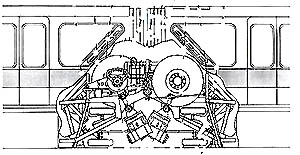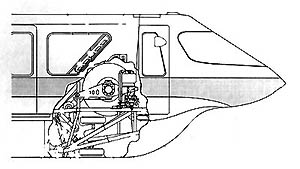 |
Disney/Bombardier Propulsion, Braking & Power The Mark VI trains have eight 100hp, 600-volt DC electric motors. These motors also act as brakes by turning the motors into generators and dissipating the power into resistor banks between each car. This is called regenerative braking. Each of the twelve load tires has an 18-inch mechanical disk brake, but the mechanical system generally accounts for less than 1/4th the braking required in normal operation. The dynamic braking slows the train to about 13 mph. Top speed of the Mark VI trains is 55 mph, but the standard operating speed at Walt Disney World is 40 mph. The propulsion system is called the "Propulsion and Dynamic Braking (P/DB) System." There are two redundant P/DB systems per train, and either is capable of running the train. Each train consumes 138 KWH (kilowatt hours) per operating hour. This translates into a per-train mile of 10.78 KWH, or 0.13 KWH per passenger mile. Power is applied to the traction motors in steps to keep current consumption within the proper limits. Acceleration is 1 mph/s, deceleration is 0.44 mph/s. The Bombardier M-VI iteration of the trains use a 750VDC primary
power source. The power is inverted into alternating current for
the traction motors. AC traction motors, also known as VVVF (Variable-Voltage,
Variable-Frequency) motors, are more controllable than DC motors.
These are the same types of motors used in the latest Japanese
Shinkansen "Bullet" trains. Maximum operating speed
is 53 mph (85 km/h) and nominal cruise speed is 45 mph (75 km/h).
Acceleration rate is 2.2 mph/s (1.0 m/s2). Normal braking rate
is the same. The minimum horizontal radius has been reduced to
175' (53.3m). Maximum sustained gradient is 6%. This design has
been proposed for
|

